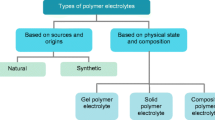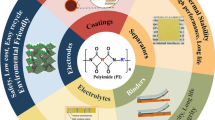Abstract
An increasing number of applications of ionic liquids (ILs) as solvents for organic synthesis have been reported in recent years, but the use in polymer synthesis is still limited. In the last few years, it has been shown that ILs can also be advantageously used for polymer synthesis. The thermal stability of polymerized ionic liquids is of great interest as it is applied to solid state electrolytes for electrochemical and electromechanical applications. In this study, the bulk copolymerization of methyl methacrylate with 1-vinyl-3-butylimidazolium hexafluorophate (VbimPF6), 1-vinyl-3-hexylimidazolium hexafluorophate (VhimPF6) 1-vinyl-3-octylimidazolium hexafluorophate (VoimPF6), 1-vinyl-3-octyl imidazolium tetrafluoroborate (VoimBF4) at 70 °C were separately proceeded at ILs doping levels of 2 mass%, 5 mass% and 8 mass%. Then the oxidative and non-oxidative thermal stability of copolymers were investigated as a function of copolymer compositions in comparison with PMMA homopolymer. Copolymerization of ILs can significantly improve the thermal stability and thermal oxidative stability of copolymers by 100 °C and 30 °C, respectively. Meanwhile, the thermal stability under nitrogen and air atmosphere increased with increasing of ILs composition.













Similar content being viewed by others
References
Thomas W. Room-temperature ionic liquids. Solvents for synthesis and catalysis. Chem Rev. 1999;99:2071–83. https://doi.org/10.1021/cr980032t.
Przemyslaw K. Application of ionic liquids as solvents for polymerization processes. Prog Polym Sci. 2004;29:3–12. https://doi.org/10.1016/j.progpolymsci.2003.10.002.
Amanda CC, Jessica LJ, Loanna N, Kim LTT, Kristin JW, David CF, James HD Jr. Novel brønsted acidic ionic liquids and their use as dual solvent-catalysts. J Am Chem Soc. 2002;124:5962–3. https://doi.org/10.1021/ja026290w.
Chen J, Lv JX, Ji YM, Ding JY, Yang XY, Zou MH, Xing LY. Alcoholysis of PET to produce dioctyl terephthalate by isooctyl alcohol with ionic liquid as cosolvent. Polym Degrad Stab. 2014;107:178–83. https://doi.org/10.1016/j.polymdegradstab.2014.05.013.
Matthew DB, Donald JL. Ionic liquids as stable solvents for ionic polymer transducers. Sens Actuators A. 2004;115:79–90. https://doi.org/10.1016/j.sna.2004.03.043.
Mustafizur R, Christopher SB. Ionic liquids: new generation stable plasticizers for poly(vinyl chloride). Polym Degrad Stab. 2006;91:3371–82. https://doi.org/10.1016/j.polymdegradstab.2006.05.012.
Mark PS, Mustafizur R, Christopher SB. Application of ionic liquids as low-volatility plasticizers for PMMA. Eur Polym J. 2003;39:1947–53. https://doi.org/10.1016/S0014-3057(03)00129-0.
Zhang BD, David AH, Su ZH. Ionic liquids as plasticizers for polyelectrolyte complexes. J Phys Chem B. 2015;119:3603–7. https://doi.org/10.1021/jp5128354.
Song XY, Zhang XJ, Wang H, Liu FS, Yu ST, Liu SW. Methanolysis of poly(lactic acid) (PLA) catalyzed by ionic liquids. Polym Degrad Stab. 2013;98:2760–4. https://doi.org/10.1016/j.polymdegradstab.2013.10.012.
Yue QF, Wang CX, Zhang LN, Ni Y, Jin YX. Glycolysis of poly(ethylene terephthalate) (PET) using basic ionic liquids as catalysts. Polym Degrad Stab. 2011;96:399–403. https://doi.org/10.1016/j.polymdegradstab.2010.12.020.
Al-Sabagh AM, Yehia FZ, Eissa AMF, Moustafa ME, Eshaq Gh, Rabie AM, Elmetwally AE. Cu- and Zn-acetate-containing ionic liquids as catalysts for the glycolysis of poly(ethylene terephthalate). Polym Degrad Stab. 2014;110:364–77. https://doi.org/10.1016/j.polymdegradstab.2014.10.005.
Peng JJ, Deng YQ. Ionic liquids catalyzed Biginelli reaction under solvent-free conditions. Tetrahedron Lett. 2001;42:5917–9. https://doi.org/10.1016/S0040-4039(01)01139-X.
Tang JB, Tang HD, Sun WL, Maciej R, Shen YQ. Poly(ionic liquid)s as new materials for CO2 absorption. J Polym Sci Part A. 2005;43:5477–89. https://doi.org/10.1002/pola.21031.
Zhu JM, Zhou JH, He KG, Zhang H. The adsorption of carbon dioxide on porous poly(ionic liquid)s. Mater Renew Energy Environ. 2011;2:1468–72. https://doi.org/10.1109/ICMREE.2011.5930611.
Tang JB, Tang HD, Sun WL, Henry P, Maciej R, Shen YQ. Poly(ionic liquid)s: a new material with enhanced and fast CO2 absorption. Chem Commun. 2005. https://doi.org/10.1039/b501940k.
Michiko H, Kaori I, Hiroyuki O. Preparation and polymerization of new organic molten salts; N-alkylimidazolium salt derivatives. Electrochim Acta. 2000;45:1291–4. https://doi.org/10.1016/S0013-4686(99)00334-5.
Satoko W, Masahiro Y, Hiromitsu N, Hiroyuki O. Highly ion conductive flexible films composed of network polymers based on polymerizable ionic liquids. Polymer. 2004;45:1577–82. https://doi.org/10.1016/j.polymer.2004.01.003.
Tang JB, Maciej R, Shen YQ. Poly(ionic liquid)s as optically transparent microwave-absorbing materials. Macromolecules. 2008;41:493–6. https://doi.org/10.1021/ma071762i.
Md Abu Bin Hasan Susan, Taketo K, Akihiro N, Masayoshi W. Ion gels prepared by in situ radical polymerization of vinyl monomers in an ionic liquid and their characterization as polymer electrolytes. J Am Chem Soc. 2005;127:4976–83. https://doi.org/10.1021/ja045155b.
Rebeca M, Francisco A, Haritz S, Jose AP, Cristina P, David M. Tailor-made polymer electrolytes based upon ionic liquids and their application in all-plastic electrochromic devices. Electrochem Commun. 2006;8:482–8. https://doi.org/10.1016/j.elecom.2006.01.013.
Takaya S, Shoko M, Takuya N, Tadayoshi A. High rate performance of a lithium polymer battery using a novel ionic liquid polymer composite. J Power Sources. 2007;164:390–6. https://doi.org/10.1016/j.jpowsour.2006.10.048.
Maciej G, Andrzej L, Izabela S. Ionic liquids as electrolytes. Electrochim Acta. 2006;51:5567–80. https://doi.org/10.1016/j.electacta.2006.03.016.
Lu W, Andrei GF, Qi BH, Elisabeth S, Benjamin RM, Ding J, Geoffrey MS, Jakub M, Dezhi Z, Gordon GW, Douglas RM, Stewart AF, Maria F. Use of ionic liquids for p-conjugated polymer electrochemical devices. Science. 2002;297:983–7. https://doi.org/10.1126/SCIENCE.1072651.
Jae-Won C, Gouri C, Yeon-Hwa K, Jac-Kwang K, James M, Prasanth R, Jou-Hyeon A, Ki-Won K, Hyo-Jun A, Doo SC, Choong ES. Poly(ethylene oxide)-based polymer electrolyte incorporating room-temperature ionic liquid for lithium batteries. Solid State Ionics. 2007;178:1235–41. https://doi.org/10.1016/j.ssi.2007.06.006.
Li ZH, Jiang J, Lei GT, Gao DS. Gel polymer electrolyte prepared by in situ polymerization of MMA monomers in room temperature ionic liquid. Polym Adv Technol. 2006;17:604–7.
Xie ZL, Aleksandra J, Wang FP, Pierre R, Alwin F, Sabine B, Andreas T. Transparent, flexible, and paramagnetic ionogels based on PMMA and the iron-based ionic liquid 1-butyl-3-methylimidazolium tetrachloroferrate(III) [Bmim][FeCl4]. J Mater Chem. 2010;20:9543–9. https://doi.org/10.1039/c0jm01733g.
Ki-Sub K, Seung-Yeob P, Sukjeong C, Huen L. Ionic liquid-polymer gel electrolytes based on morpholium salt and PVDF(HFP) copolymer. J Power Sources. 2006;155:385–90. https://doi.org/10.1016/j.jpowsour.2005.05.018.
Chen H, Jae-Hong C, Salas-de D, la C, Karen IW, Yossef AE. Polymerized ionic liquids the effect of random copolymer composition on ion conduction. Macromolecules. 2009;42:4809–16. https://doi.org/10.1021/ma900713e.
Feng Y, John T. Surfactant ionic liquid-based microemulsions for polymerization. Chem Commun. 2006;5(25):2696–8. https://doi.org/10.1039/b605287h.
Hideharu M, Masahito Y, Takeshi E. RAFT polymerization of N-vinylimidazo -lium salts and synthesis of thermoresponsive ionic liquid block N-copolymers. Macromolecules. 2009;42:8082–92. https://doi.org/10.1021/ma901180j.
Kari V, David M, Yves G, Daniel T. Polymeric vesicles and micelles obtained by self-assembly of ionic liquid-based block copolymers triggered by anion or solvent exchange. Macromolecules. 2009;42:5167–74. https://doi.org/10.1021/ma900-549k.
Kari V, Suresh KJ, Alaitz R, Rebeca M, Jose AP, David M, Daniel T, Yves G. Synthesis by RAFT and ionic responsiveness of double hydrophilic block copolymers based on ionic liquid monomer units. Macromolecules. 2008;41:6299–308. https://doi.org/10.1021/ma800677h.
Klaus T, Nancy W, Jone T. Core-shell particle interconversion with di-stimuli-responsive diblock copolymer. Chem Commun. 2009. https://doi.org/10.1039/b912148j.
Liang G, Jae-Hong C, Karen IW, Yossef AE. Block copolymerionic liquid films: the effect of ionic liquid composition on morphology and ion conduction. Polymer. 2001;51:5516–24. https://doi.org/10.1016/j.polymer.2010.09.026.
Masahiro Y, Wataru O, Hiroyuki O. Novel polymer electrolytes prepared by copolymerization of ionic liquid monomers. Polym Adv Technol. 2002;13:589–94. https://doi.org/10.1002/pat.261.
Kozo M, Bandana T, Takeshi E. Preparation of networked polymer electrolytes by copolymerization of a methacrylate with an imidazolium salt structure and an ethyleneglycol dimethacrylate in the presence of lithium bis(trifluoro -methanesulfonyl)imide. Polym Bull. 2011;66:779–84. https://doi.org/10.1007/s00289-010-0311-0.
Jae-Hong C, Xie W, Gu YY, Daniel F, Timothy PL. Single ion conducting, polymerized ionic liquid triblock copolymer films high capacitance electrolyte gates for n-type transistors. Appl Mater Interfaces. 2015;7(13):7294–302. https://doi.org/10.1021/acsami.5b00495.
Kozo M, Bandana T, Takeshi E. Methacrylate-based ionic liquid: radical polymerization/copolymerization with methyl methacrylate and evaluation of molecular weight of the obtained homopolymers. Polym Bull. 2011;66:199–210. https://doi.org/10.1007/s00289-010-0275-0.
Dustin E, Lisa S, Thomas M, John T. Thermomechanical synergisms from ionic liquid doping of poly(methyl methacrylate). Macro Lett. 2013;2:901–5. https://doi.org/10.1021/mz400429x.
Dustin E. Materials and coating derived from the polymerizable ionic liquid surfactant 1-(2-Acryloyloxyundecyl)-3-methylimidazolium bromide. Masters Theses and Doctoral Dissertation. 2008:159. http://commons.emich.edu/theses/ 159.
Takashi K, Atsushi I, James EB, Koichi H, Tatsuki K, Eiji M. Effects of weak linkages on the thermal and oxidative degradation of poly(methyl methacrylates). Macromolecules. 1986;19:2160–8. https://doi.org/10.1021/ma00162a010.
Begg CG, Grimmett MR, Wethey PD. The thermally induced rearrangement of 1-substituted imidazoles. Aust J Chem. 1973;26:2435–46. https://doi.org/10.1071/CH9732435.
Wataru O, Satoko W, Hiromitsu N, Hiroyuki O. Effect of cation structure on the electrochemical and thermal properties of ion conductive polymers obtained from polymerizable ionic liquids. Electrochim Acta. 2006;51:2614–9. https://doi.org/10.1016/j.electacta.2005.07.043.
Helen LN, Karen L, Leisl H, Alan BM. Thermal properties of imidazolium ionic liquids. Thermochim Acta. 2000;357–358:97–102. https://doi.org/10.1016/s0040-6031(00)00373-7.
Rebeca M, Marta SP, Beatriz LR, Enrique LC, Estibalitz O, Hans G, David M. Synthesis and characterization of new polymeric ionic liquid microgels. J Polym Sci Part A. 2006;44:3958–65. https://doi.org/10.1002/pola.21483.
Walid HA, Jeffrey WG, Marc N, Richard HH Jr, Thomas ES, John C, Paul CT, Hugh CD, Douglas MF. Thermal degradation studies of alkyl-imidazolium salts and their application in nanocomposites. Thermochim Acta. 2004;409:3–11. https://doi.org/10.1016/S0040-6031(03)00334-4.
Toshimi H, Takashi K, James EB. Thermal and oxidative degradation of poly(methyl methacrylate): weight Loss. Macromolecules. 1985;18:1410–8. https://doi.org/10.1021/ma00144a003.
Acknowledgements
Financial support of this work from the National Science Foundation of China (Nos. 51273026 and 51173020), the Young Scholar Scientific Foundation of Science and Technology Department of Jilin Province (20130522140JH) and Petrochina Innovation Foundation (2013D-5006-0502) is gratefully acknowledged.
Author information
Authors and Affiliations
Corresponding author
Ethics declarations
Conflict of interests
The authors declare that they have no known competing financial interests or personal relationships that could have appeared to influence the work reported in this paper.
Additional information
Publisher's Note
Springer Nature remains neutral with regard to jurisdictional claims in published maps and institutional affiliations.
Rights and permissions
Springer Nature or its licensor (e.g. a society or other partner) holds exclusive rights to this article under a publishing agreement with the author(s) or other rightsholder(s); author self-archiving of the accepted manuscript version of this article is solely governed by the terms of such publishing agreement and applicable law.
About this article
Cite this article
Ma, J., Cao, C. Effect of polymerized ionic liquids on thermal stability of poly(methyl methacrylate). J Therm Anal Calorim 148, 12433–12443 (2023). https://doi.org/10.1007/s10973-023-12562-x
Received:
Accepted:
Published:
Issue Date:
DOI: https://doi.org/10.1007/s10973-023-12562-x




